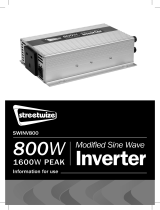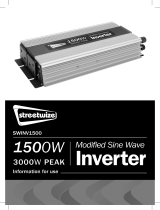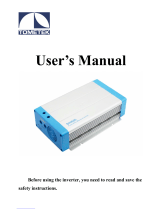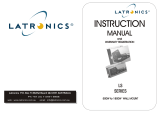PowerTech MI5708 User manual
- Category
- Smoke detectors
- Type
- User manual
This manual is also suitable for

Version 1.3-130603
0
Pure Sine Wave
DC TO AC
Power Inverter
User’s Manual
Distributed by:
Tech Brands by Electus Distribution
320 Victoria Road, Rydalmere NSW Australia
Tel: 1300 738 555
Fax: 1300 738 500
www.techbrands.com

1
Contents
1. Specifications …………………………………………………………..........2
2. Important Safety Guidelines and Instructions……………….……3~4
3. Features…………………………………………..………………..….....4
4. Applications and Descriptions……………………..………..……..…..5
5. Introduction and Operation ……………………………..…..….6~14
6. Mechanical Drawings…………………………………….….…....15~18
7. Trouble Shooting……………………………………….......................19
8. Maintenance……………………………………………..…….............19
9. Warranty………………………………………………..………............20

Version 1.3-130603
2
1. Specifications:
MODEL: MI5700 MI5702 MI5703 MI5704 MI5706 MI5708 MI5710 MI5712
OUTPUT
Continuous output 180W 360W 800W 1100W 1500W 2000W
Surge 360W 720W 1600W 2200W 3000W 4000W
Voltage AC230V
Frequency 50Hz
Waveform Pure Sine Wave(THD<3%)
Regulation (Typ.) Vrms <±3%
USB Output (Typ.) DC 5V ± 5% 500mA
INPUT
Battery Voltage 12V 24V 12V 24V
DC Current (Typ.) 20A 40A 20A 80A 120A 160A 220A 110A
Low Battery Alarm 10.6±0.2V 21.2±0.3V 10.6±0.2V 21.2±0.3V
Low Battery Protection 10±0.2V 20±0.3V 10±0.2V 20±0.3V
High Battery Protection
15±0.2V 30±0.3V 15±0.2V 30±0.3V
No Load Current 0.35A 0.4A 0.2A 0.5A 0.75A 0.85A 0.95A 0.5A
Stand-by Current 0.08A 0.1A 0.05A 0.15A 0.18A 0.2A 0.2A 0.15A
Efficiency (Typ.) 89% 90% 92% 91% 91% 91% 91% 93%
Protection High Temperature ; Short-Circuit ; Over Load ; Input Voltage
Load
Control
Load 95~100% Alarm but remain working
Load 105% Alarm then after 1 minute shut down
Load 120% Alarm then after 5 seconds shut down
Operating temperature range -20℃ ~ 40℃
Operation Humidity 20 ~ 90% RH
Storage Temp Humidity -30℃ ~ 70℃, 10~90% RH
Intelligent Design Heat Auto
Control
Fans slow speeding up 38℃±3,Fans start speeding up:42℃±3
High Temperature Shut Down : 65℃±3,Restart Output: 56℃±3
Indicator Inverter : Green LED / Over Load : Red LED / Over Temperature : Yellow LED
Others Soft Start-up Soft Started Function
Remote Controller
NO YES
Mechanical D*W*H(mm) 186x117x57 230x118x57 295x165x57 364x180x74 350x230x74 450x230x74
Weight(kg) 0.85kg 1.05kg 1.9kg 3.6kg 4.2kg 5.5kg
Note Efficency test done at approx 75% load, with 13V input for 12V model, 26V input for 24V model
Note: The specifications are subject to change without prior notice.

3
WARNING!
Before using the inverter, read and save the
safety instructions carefully.
2. Important Safety Guidelines and Instructions
To avoid danger of electric shocks, fire, injury when using electrical
equipment, please read this manual carefully before installing and starting
up. This instruction manual should be carried with the device and stored in a
safe place.
Failure to observe this instruction can cause material damage, device
malfunction or danger of injuries. Fundamental safety measures should be
observed when using electrical equipment.
2-1. General Safety and installation Precautions
Do not expose the inverter to water, snow, spray, or dust. Keep the inverter in a dry, cool,
clean and ventilated place. To reduce risk of hazard, do not cover or obstruct the
ventilation ports or fans.
Do not install the inverter in a zero-clearance compartment. Overheating may occur.
The inverter must be kept in a safe place out of the reach of children. Make sure that
the device is properly secured.
To avoid a risk of fire and electronic shock, make sure that existing wiring and
terminations are in good electrical condition, secure and not undersized. Do not operate
the inverter with damaged or substandard wiring.
If the fuse blows or protection fails, parts of the inverter remain functional. Only
qualified personnel should carry out maintenance or repair work as some components
in the inverter can hold very high voltages even after being turned off.
To prevent fire or explosion, do not put batteries, flammable materials, or anything that
has to be ignition-protected around the inverter.
Do not reverse the polarity of the DC input connections, as this may cause permanent
damage to the inverter. Make sure the (+) and (-) cables from the battery are connected
to the corresponding terminals of the inverter.
Always disconnect the inverter when not in use. To prevent electrical shock, do not
operate without connecting the inverter to ground.

Version 1.3-130603
4
2-2. Precautions When Working and Operating with Batteries
Never smoke or produce sparks or flame in the vicinity of the battery or the engine.
If battery acid contacts skin or clothes, you shall wash it out with soap and water
immediately. If battery acid contacts your eyes, you shall wash it out with cold running
water for at least 20 minutes and get medical attention immediately.
Make sure the power plug is firmly connected in the socket. If the connection is not
firm enough, the plug will heat up and cause damage to device.
Do not start the engine while the inverter is on, this may cause inverter to shut down.
The inverter can be operated with the engine running or off. If it is necessary to
operate the device for a long time, start the engine to recharge the vehicle battery.
Do not drop or place metal tools on the battery. The spark or short-circuit on the
battery of other electrical part may cause an explosion.
Remove personal metal items such as rings, bracelets, necklaces, and watches when
operating with lead-acid batteries. These are electrically conductive devices and may
cause short circuit and very high temperature, resulting in personal injury.
USB supply output DC 5V 500mA.
3. Features
Pure Sine Wave output with THD<3%
Advanced microprocessor design
Soft Start Function : High surge capacity for starting demanding loads
High efficiency up to 93% on high power models
Input and Output electrically isolated
Multi-stage power saving mode : conserve energy with green power
Multi-stages intelligent cooling system
Intelligent output overload protection :
Load 95~100% alarm sounds but remains working
Load 105% alarm sounds, then after 1 minute shut down
Load 120% alarm sounds, then after 5 seconds shut down
Suitable for resistive, capacitive, and inductive loads
Full protection : output short circuit, input high/low voltage,
temperature
Wired remote control included with higher power models

5
4. Applications and Descriptions
Compared to a commercial grade Modified Sine Wave Power
Inverter, the output of Pure Sine Wave inverters are more suitable
for sensitive electronic equipments. Pure Sine Wave Inverters
produce power which is identical to, and in most cases better than
the power from the public utility power grid system.
Industrial equipment-metal halide lamp, high-pressure sodium lamp,
etc.
Power tools-circular saws, drills, grinders, sanders, buffers, weed and
hedge trimmers, air compressors, etc.
Office equipment-computers, printers, cash registers, monitors,
facsimile machines, scanner, etc.
Household appliances-vacuum cleaners, fans, fluorescent and
incandescent lights, shavers, sewing machines.
Kitchen appliances-coffee makers, small refrigerators, blenders, ice
markers, toasters, etc.
Home entertainment electronics-television, VCRS, BlueRay/DVD
players, radios, video games, stereos, musical instruments, satellite
equipment, etc.
USB 5V DC is for-digital camera, cell phone, video game, MP3, MP4,
PDA

Version 1.3-130603
6
5. Introduction & Operation
Please read the instructions carefully before you install and operate the
inverter.
This power inverter series is one of the most advanced and high-quality
types available.
To get the most optimum power from the inverter, it must be installed and
used properly. The AC output voltage corresponds to the standard pure
sine wave as supplied by energy authorities (as per AS 60038).
5-1. Inverter Operation:
Make sure the inverter power switch is in the OFF position.
Connect the inverter to a fully charged battery.
Use the “ON/OFF” switch to turn the inverter ON or OFF.
Connect the electric appliance to AC output socket of the inverter.
Turn the inverter “ON” – the Green LED should light up, indicating power is on
and inverter is functional. Appliance can now be used.
When finished, turn inverter power switch to “OFF” position, this will shut down
the inverter
When using wired remote controller make sure the inverter “ON/OFF” Switch is
in the “ON”position.
5-2. Front Panel Operations
I NV. POWER/
OVER. L OAD OVER.
T E MP
MI5704
1 2 3 4
ON

7
MI5708
MI5710
MI5712
ON/OFF: Power switch
Remote: Input terminal of wired remote control. Make sure the power
switch is turned to the “ON” position. The remote only controls the power
of the inverter (ON/OFF).
Power Saving Mode: Power Saving Mode is adjustable and set by the Dip
Switch, SW1 and SW2. Setting this mode reduces the inverter’s standby
power consumption if the applied AC load is below the set threshold in the
table below. After setting the DIP switches, you must restart the inverter.
Noted: these are nominal values only and may vary.
MI5700
MI5702
MI5703
MI5704
MI5706
MI5708
MI5710
MI5712
SW1 SW2
No Saving No Saving OFF OFF
20W 30W OFF ON
No Saving 50W ON OFF
20W 100W ON ON

Version 1.3-130603
8
USB 5V 500MA: To provide DC output 5V 500mA.
AC OUTPUT SOCKET: AC OUTPUT SOCKET 1 , SOCKET 2 : Connect your
230VAC appliances here, ensuring the loads are within the power rating of
the inverter.
LED Indicators:
INV.POWER: Power on, normal operation. Green LED
OVER LOAD: Over load, Red LED
OVER TEMP.: Over temperature, Yellow LED
Green LED LED Show Status
Solid
__________
Normal
Red LED
LED Show
Status
Solid __________ Over Load
Slow Blink
__ __ __
Battery High voltage
Fast Blink
-
- - - - Battery Low voltage
Yellow LED LED Show Status
Solid
__________
Over Temperature

9
5-3. Rear Panel Operations
SONDAR
R
SONDAR
R
SONDAR
R
SONDAR
R

Version 1.3-130603
10
SONDAR
R
SONDAR
R
FAN Ventilation: Make sure there is a minimum clearance of 30cm from the
fan grilles to allow adequate airflow into the inverter for cooling. Do not mount
the inverter in a completely sealed enclosure. The enclosure should also have
ventilation ports to allow adequate airflow.
DC Input Terminals: Connect DC terminals to a battery (or battery bank)
with appropriate voltage for the inverter being used.
WARNING!
Reverse polarity connection will blow the internal fuse and may
damage the inverter permanently.
POS +: Represents positive terminal
NEG - : Represents negative terminal
Connect the (+) and (-) cables from the battery to the respective terminals
of the inverter
Ground connection: Use wire(>#12) to connect chassis ground
MODEL DC Input voltage
Minimum Maximum
12V 10.1V 15V
24V 20.1V 30V

11
WARNING!
Operating the inverter without a proper ground connection
may cause an electrical hazard. Refer to relevant wiring
standards or consult a professional.
5-4. Features of protection:
DC Input Voltage Protection:
Model
Over Voltage Low
Voltage
Alarm
Low Voltage
High voltage
Shut-down Restart Low voltage
Shut-down Restart
12V 15.1V 14.5V 10.6V 10V 12.5V
24V 30.1V 29V 21.2V 20V 25V
Over Temperature Protection:
65℃ 56℃
Shut-down Restart
Model
Over Load Protection:
1 min. Shut-down 5 sec. Shut-down
MI5700 190W 220W
MI5702 380W 430W
MI5703 380W 430W
MI5704 820W 950W
MI5706 1250W 1320W
MI5708 1600W 1800W
MI5710/MI5712 2100W 2400W

Version 1.3-130603
12
5-5. Buzzer Alarm Fault Status:
Fault Type
:
Sound Signal Sound Symbol
Low Battery Alarm,Stage 1 “BEEP” two times slowly - - - -
Low Battery Protection “BEEP” two times fast - - - - - - - - - -
High Battery Protection “BEEP” two times fast
(long beeps)
― ― ― ― ― ―
Heat Protection “BEEP” one time (long
beeps)
__ __ __ __
Load Control Alarm,Stage 1 “BEEP” three times
Slowly
- - - - - -
Load Control Alarm,Stage 2 “BEEP” three times at
medium rate
- - - - - - - - -
Load Control Alarm,Stage 3 “BEEP” three times fast - - - - - - - - - - - -

13
5-6. Installation:
The power inverter should be installed in an environment that
meets the following requirements.
Dry --- Do not allow water to drip on or enter into the inverter.
Cool --- Ambient air temperature should be between 0℃ and 40℃, the
cooler the better.
Safe --- Do not install the inverter in a battery compartment or other areas
where flammable fumes may exist, such as fuel storage areas or engine
compartments.
Ventilated --- Keep the inverter at least 10cm away from surrounding
objects, and at least 30cm from fans. Ensure the ventilation slots on the
rear and the bottom of the unit are not obstructed in any way.
Dust --- Do not install the inverter in a dusty environment. Dust can be
drawn into the unit when the cooling fan is working and cause damage to
the circuits.
Close to batteries --- Avoid excessive cable lengths. Do not install the
inverter in the same compartment as batteries. Use the recommended
wire lengths and sizes. Do not mount the inverter where it will be exposed
to the gases from the batteries, as prolonged exposure will damage the
inverter.
WARNING!
Shock Hazard. Before proceeding, carefully check that
inverter is NOT connected to any batteries, and that all
wiring is disconnected from any electrical sources. NEVER
connect the AC output terminals of the inverter to an
incoming AC source such as mains, or an AC generator.
5-7. DC Wiring Connections:
Follow this procedure to connect the battery cables to the DC input
terminals of the inverter. The DC cables should be as short as possible
(less than 3 meters) and large enough to handle the required current in
accordance with the electrical codes or regulations applicable to the
installation.
Cables that are too small in gauge (too thin) or too long will drastically
reduce inverter performance, causing poor surge capability and frequent

Version 1.3-130603
14
low-input voltage warnings and shutdowns. This is due to the DC voltage
drop in the cables from the battery to the inverter.
The longer and narrower the cables, the greater the voltage drops.
WARNING!
DC wiring terminations.
Ensure all the DC connections and terminations are
secure and tight. Loose connection can cause
overheating and fire.
The following table recommends the cable size for optimum inverter
performance.
SU Series Wire AWG Inline Fuse Description
MI5703 #12 25A
Black 1M + Red 1M
MI5702 #10 25A*2
MI5704 #6 30A*4
MI5712 #4 25A*6
MI5706
30A*6
MI5708
#2
30A*8
MI5710 #1 25A*12
Lay the flexible earth cable from the earthing point of the vehicle to the
earthing point of the inverter.
If cables are to be fed through metal walls or walls with sharp edges, use
glands or proper bushings to prevent cable damage.
Do not lay cables that are loose or bent next to electrically conductive
materials.

15
6. Mechanical Drawings
SONDAR
R
SONDAR
R
I NV. POWER/
OVER. LOAD OVER.
T E MP

Version 1.3-130603
16
SONDAR
R

17
SONDAR
R

Version 1.3-130603
18
.

19
Trouble Shooting:
WARNING!
Do not open or disassemble the inverter.
Attempting to service the unit yourself may cause the risk of
electrical shock or fire.
Problems and
Symptoms Possible Cause Solutions
Does not turn on Battery damaged, or
bad DC cable
connection
Change battery, check DC cables
and terminations
No AC power output.
Red LED always on
Output overload or
short circuit
Decrease load, check AC cable.
Remove load, check output
No AC power output.
Red LED blink slowly
Low battery voltage or
high battery voltage
Check battery voltage, charger
battery, check DC cable
terminations
No AC power output.
Yellow LED blink slowly
Over temperature
shut-down
Check if there is proper
ventillation. Check if there are any
objects or barriers blocking the
vents or fans
8. Maintenance:
To keep your inverter operating properly, there is very little maintenance
required. Make sure the inverter is switched OFF. Clean the exterior
periodically with a cloth to prevent accumulation of dust and dirt. Do not use
sharp or hard objects to clean, these may damage the device. Check the DC
cables and terminations, making sure they are secure and tight.
Page is loading ...
-
 1
1
-
 2
2
-
 3
3
-
 4
4
-
 5
5
-
 6
6
-
 7
7
-
 8
8
-
 9
9
-
 10
10
-
 11
11
-
 12
12
-
 13
13
-
 14
14
-
 15
15
-
 16
16
-
 17
17
-
 18
18
-
 19
19
-
 20
20
-
 21
21
PowerTech MI5708 User manual
- Category
- Smoke detectors
- Type
- User manual
- This manual is also suitable for
Ask a question and I''ll find the answer in the document
Finding information in a document is now easier with AI
Related papers
Other documents
-
DigiTech XC0400 Owner's manual
-
 ROVIN Collapsible Mosquito Zapper Camping Lantern User manual
ROVIN Collapsible Mosquito Zapper Camping Lantern User manual
-
DigiTech XC5800 Owner's manual
-
 Streetwize SWINV800 Owner's manual
Streetwize SWINV800 Owner's manual
-
 Streetwize SWINV1500 Owner's manual
Streetwize SWINV1500 Owner's manual
-
 LG Uplus SSE-303 User manual
LG Uplus SSE-303 User manual
-
 Tometek SHI600-12 User manual
Tometek SHI600-12 User manual
-
Mercury IPS1000-12 User manual
-
Imazing IM 39 User manual
-
 Latronics LS Series 500W to 1800W Wall Mount User manual
Latronics LS Series 500W to 1800W Wall Mount User manual


























